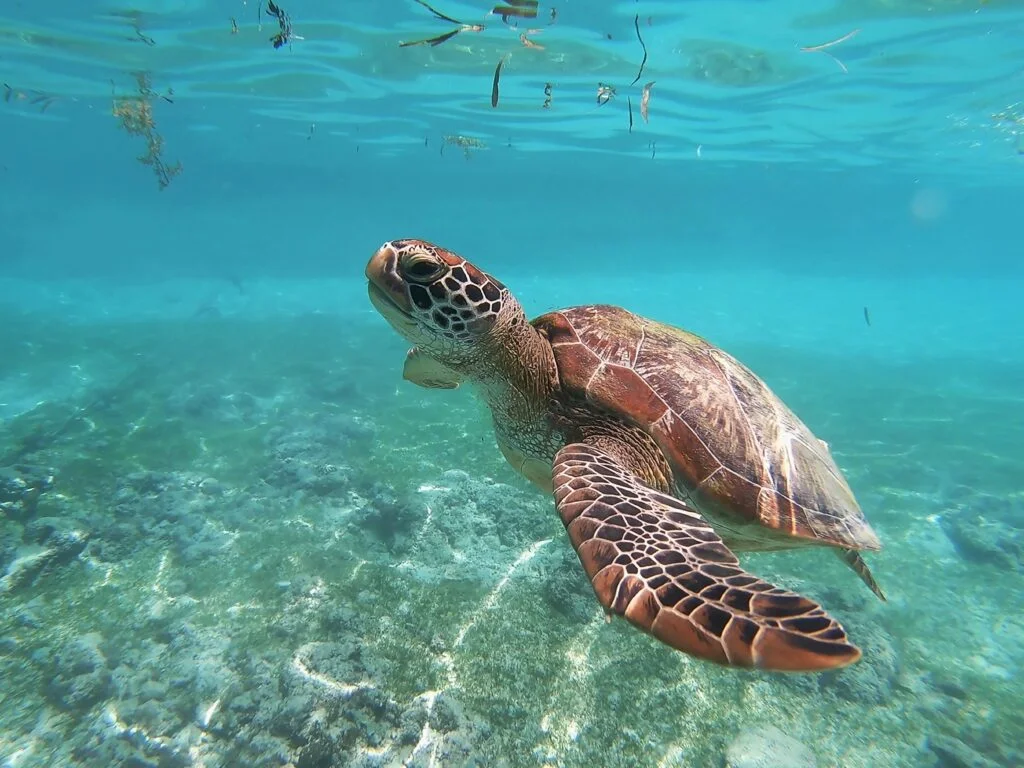
Commonly Found Sea Turtle Species:
Loggerhead Sea Turtles (Caretta caretta): Renowned for its massive, block-like head, the loggerhead is an impressive creature. As one of the larger sea turtles, adult loggerheads boast an average weight of 275 pounds and a shell length of approximately 3 feet. Its carapace showcases a striking combination of ruddy brown on top and creamy yellow underneath, with a broad front and a tapering rear. Notably, each flipper of the loggerhead is equipped with two formidable claws. While adult males possess a long tail and females have a short one, the tail of a juvenile cannot be determined externally.
The loggerhead’s powerful jaws are specially adapted for its preferred diet of clams, crabs, and other armored creatures. Although not the fastest swimmer among sea turtles, the loggerhead occasionally falls victim to sharks, resulting in missing flippers or damaged shells, a sight not uncommon in these waters. Nonetheless, the loggerhead compensates for its moderate speed with exceptional endurance.
GREEN TURTLE (Chelonia mydas): The Green Turtle, scientifically known as Chelonia mydas, is a remarkable species distinguished by its unique traits. Its name is derived from the green body fat it possesses. In the New World, European settlers highly valued green turtles for their meat, hide, eggs, and the prized “calipee” – the fat attached to the lower shell, which formed the basis of the popular green turtle soup.
Compared to the bulkier loggerhead, the green turtle boasts a more streamlined appearance. With an average weight of 350 pounds, it possesses a relatively small head in proportion to its body size. The oval-shaped upper shell, measuring around 3.3 feet in length, showcases an olive-brown color with distinct darker streaks. On the other hand, its lower shell, known as the plastron, exhibits a vibrant yellow hue.

The leatherback sea turtle is an intriguing and distinctive creature, standing out even among its sea turtle counterparts. It possesses exceptional characteristics that set it apart – larger size, deeper diving capability, extensive travel range, and a remarkable tolerance for colder waters – surpassing any other sea turtle species. On average, leatherbacks measure around 6 feet in length and weigh between 500 to 1,500 pounds. However, the largest recorded leatherback reached nearly 10 feet in length and weighed over 2,000 pounds.
One of the defining features of leatherbacks is their unique appearance. Instead of a traditional shell covered in scales or shields, they have a firm, leathery skin with seven prominent ridges running lengthwise along their backs. Their coloration typically consists of black with striking white, pink, and blue patterns, while their flippers lack claws. Leatherbacks have specialized feeding habits, primarily consuming soft-bodied creatures like jellyfish. Their throat cavity and scissor-like jaws are lined with stiff spines, aiding in the consumption of these slippery and soft prey. Interestingly, young leatherbacks in captivity can consume up to twice their own weight in jellyfish on a daily basis.
As true inhabitants of the deep sea, leatherbacks exhibit remarkable diving capabilities, reaching depths of over 3,000 feet. They are also known for their extensive migratory patterns, traveling distances exceeding 3,000 miles from their nesting beaches. Leatherbacks can be found across the Atlantic, Pacific, and Indian Oceans, with their distribution extending as far north as Alaska and Labrador. Researchers have discovered that leatherbacks possess the unique ability to regulate their body temperature, allowing them to survive in colder waters. These remarkable creatures can be found in Florida’s coastal waters, with a small population of 30 to 60 individuals nesting in the state each year.
